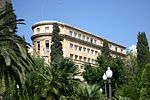Tarraco
Archaeological sites in SpainCities founded by RomeRoman sites in SpainRoman towns and cities in SpainTarragona ... and 1 more
World Heritage Sites in Spain

Tarraco is the ancient name of the current city of Tarragona (Catalonia, Spain). It was the oldest Roman settlement on the Iberian Peninsula. It became the capital of Hispania Tarraconensis following the latter's creation during the Roman Empire. In 2000, the archaeological ensemble of Tarraco was declared a World Heritage Site by UNESCO.
Excerpt from the Wikipedia article Tarraco (License: CC BY-SA 3.0, Authors, Images).Tarraco
Rambla Vella, Tarragona
Geographical coordinates (GPS) Address Nearby Places Show on map
Geographical coordinates (GPS)
| Latitude | Longitude |
|---|---|
| N 41.116388888889 ° | E 1.2552777777778 ° |
Address
Rambla Vella 29
43001 Tarragona
Catalonia, Spain
Open on Google Maps










